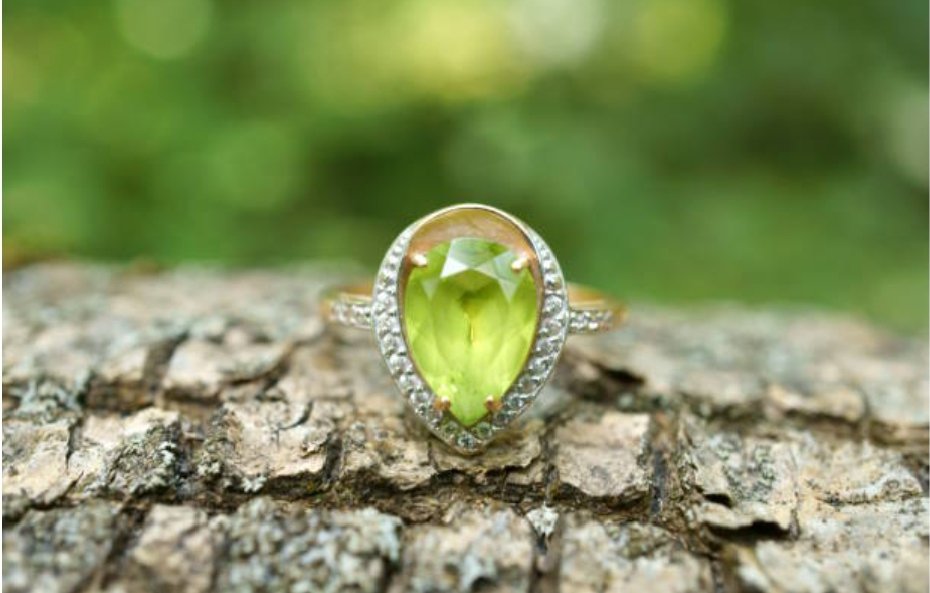Peridot, with its striking green hues, is a gemstone steeped in a rich and varied history that spans thousands of years. Known for its distinctive color and unique properties, peridot has been cherished and revered across different cultures and epochs. Here’s an exploration of the historical journey of peridot rings and how this vibrant gemstone has woven itself into the fabric of human history.
Ancient Beginnings
Egyptian Reverence: The history of peridot dates back to ancient Egypt, where it was highly valued by pharaohs and nobles. The gemstone was referred to as the “gem of the sun” due to its brilliant green color, which was believed to hold magical properties. Ancient Egyptians used peridot in various forms of jewelry, including rings, and considered it a powerful protector against nightmares and evil spirits.
The ancient Egyptians mined peridot on the island of Zabargad, located in the Red Sea. This site, known for its rich deposits of peridot, was a significant source of the gemstone in antiquity. The reverence for peridot was so profound that it was often used in royal adornments and burial artifacts, symbolizing prosperity and divine favor.
Roman and Byzantine Influence: Peridot’s allure continued through the Roman Empire, where it was prized by the wealthy and powerful. Roman jewelers valued peridot for its vibrant green color, which they believed could enhance the wearer’s health and well-being. During the Byzantine era, peridot remained a popular gemstone, often set in elaborate jewelry pieces that showcased intricate craftsmanship.
Medieval and Renaissance Periods
Medieval Beliefs: During the Middle Ages, peridot was often associated with healing and protection. It was believed to possess curative properties, particularly for digestive and mental health issues. Medieval alchemists and scholars wrote about peridot’s supposed ability to dispel negative emotions and bring about tranquility and clarity.
The gemstone also found its place in religious contexts during this period. Peridot was used in ecclesiastical jewelry and artifacts, with its vibrant green color symbolizing faith, renewal, and hope. It was sometimes included in ceremonial regalia, highlighting its esteemed status among both secular and religious figures.
Renaissance Revival: The Renaissance period saw a renewed interest in classical styles and materials, including gemstones like peridot. Jewelers of the time revived ancient techniques and designs, incorporating peridot into beautifully crafted rings and other jewelry pieces. The gemstone’s popularity persisted among European aristocracy, who appreciated its beauty and symbolic significance.
Colonial and 19th Century Discoveries
Colonial Era: The fascination with peridot continued into the colonial era, particularly as European explorers encountered new sources of gemstones. The discovery of peridot in other regions, including the United States, expanded the gemstone’s availability and contributed to its growing popularity.
19th Century Rediscovery: In the 19th century, peridot experienced a resurgence in interest due to renewed mining efforts and the discovery of new deposits. Notably, peridot was found in the U.S. state of Arizona, where it was mined from the San Carlos Apache Reservation. This new source helped to increase the gemstone’s availability and affordability, making it more accessible to a broader audience.
Modern Era and Contemporary Appreciation
20th Century Trends: The 20th century saw peridot being featured prominently in both high fashion and fine jewelry. Its vibrant color and relatively low cost compared to other gemstones like emeralds or diamonds made it an attractive option for both designers and consumers. Peridot rings became popular in various settings and styles, reflecting its versatility and enduring appeal.
Contemporary Usage: In contemporary times, peridot continues to be a cherished gemstone, appreciated for its unique color and historical significance. It is often chosen as a birthstone for those born in August, and its association with renewal and vitality resonates with modern consumers. Peridot rings are crafted in a range of styles, from classic solitaire settings to elaborate vintage designs, showcasing the gemstone’s adaptability and ongoing popularity.
Symbolism and Significance
Cultural Symbolism: Throughout its history, peridot has been imbued with a range of symbolic meanings. In ancient times, it was considered a powerful talisman with protective and healing properties. In modern contexts, peridot is often associated with qualities such as renewal, growth, and prosperity. Its bright green color is seen as a symbol of vitality and positive energy, making it a popular choice for various personal and celebratory occasions.
Historical Legacy: The enduring legacy of peridot is a testament to its timeless beauty and significance. From its use in ancient Egyptian jewelry to its place in contemporary fashion, peridot has maintained its status as a gemstone of both aesthetic and symbolic value. Its rich history and varied uses reflect its importance across different cultures and epochs, cementing its place in the world of fine jewelry.
Conclusion
The history of peridot rings is a fascinating journey through ancient reverence, medieval beliefs, and modern appreciation. From its origins in ancient Egypt to its place in contemporary jewelry design, peridot has captured the imagination of people across centuries with its vibrant color and symbolic meaning.
Whether worn as a personal adornment or given as a meaningful gift, peridot rings continue to reflect the gemstone’s rich heritage and timeless appeal. The historical journey of peridot underscores its enduring allure and significance, making it a cherished choice for those who appreciate both beauty and history in their jewelry.
